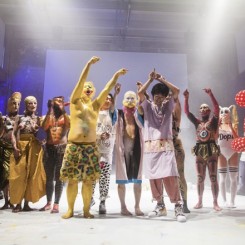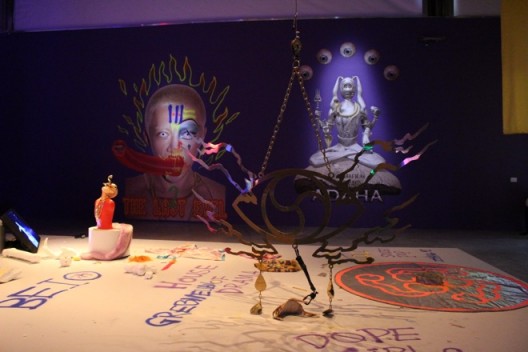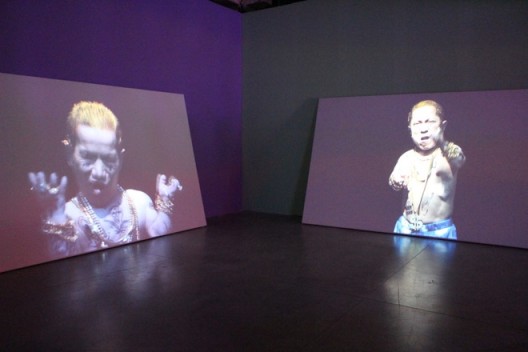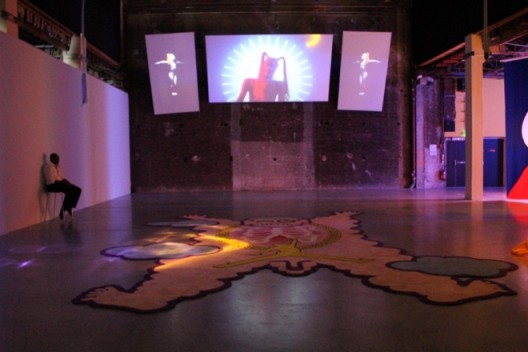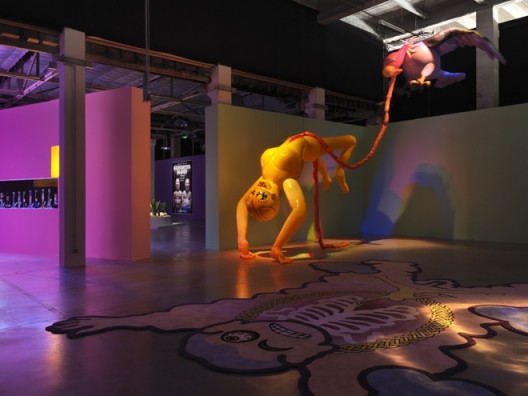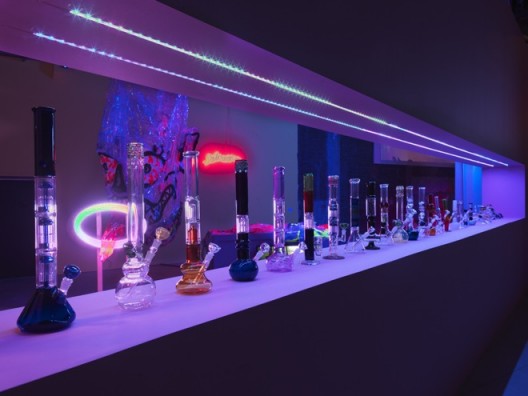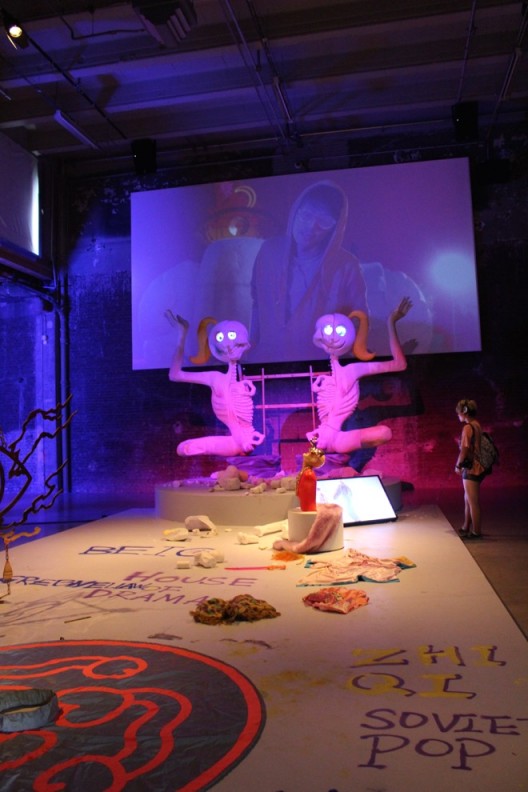本文仅限英文阅读
Palais de Tokyo (13 Avenue du Président Wilson, 75116 Paris, France), Jun 24–Sept 13, 2015
“Do not go gentle into that good night.
Rage, rage against the dying of the light.”
—Dylan Thomas
The psychotropic carnival that is Chen Tianzhuo is here in full force, this time at the Palais de Tokyo in Paris with his first solo outside China. In the vast granite-industrial complex containing disparate solo exhibitions by Céleste Boursier-Mougenot, Patrick Neu, Korakrit Arunanondchai and Jesper Just, Chen Tianzhuo’s practically shouts down the other works—on the level of pure volume. Only Arunanondchai, who is displaying “Painting with history in a room filled with people with funny names 3” in the next gallery, managed to source slightly more hues from the color spectrum by literally drenching an army of white mannequins with buckets of paint. But unlike Arunanondchai, who streamlines his narrative of Thailand’s religion and spirituality into a tight finish, Chen Tianzhuo seems to be reveling in the sheer joy of artistic freedom that he knows is not to be taken for granted. Here, in Paris, Chen’s earlier concepts privileging the subculture of “drag queens, street art, steam punk, [and] rave culture” are interlaced in a “fictitious religion, which explores the notions of fetishes, immortality and the fragility of our lives”.
Chen Tianzhuo has fabricated a house of worship in which the cult of his unique religion—loosely based on Tibetan Buddhism—flares to life. At the entrance, an immense banner greets the viewers with the curious words “Ordo Ab Chaos”. According to the artist, the phrase is Latin for “Order out of chaos” and represents his notion of “utopian longing”. Undisputedly, pandemonium and confusion rule supreme in this garden of paradise Chen has envisioned. A floor-to-ceiling diptych composed of two posters looms large like a side altar piece. The left panel portrays the beautiful and frightfully painted visage of an androgynous creature in all his/her sacrilegious glory. The black and white orbs of its eyes throw a challenging glare at the viewer as an erect penis emerges from its mouth like an over-extended tongue. The bleached-blonde cropped head emits a psychedelic spike of flames that is balanced by the searing words “2 THE LAST EVIL” catching fire as it stretches across the lower panel. The poster on the right depicts the ghostly deity ADAHA whom Chen also refers to as “Sailor Moon” appropriated from Beio (Chen’s artistic collaborator) seated in a lotus pose. Her flaccid ponytails hang like drooping rabbit ears; two of her hands hold onto her accouterments while the other two enact an indistinct mudra. The emphatic text “DECEMBER 18, IMAX 3D, ADAHA” gives her the appearance of a famous actor starring in an upcoming movie.
“The reason for using Beio as the main character in much of my art is that his body is very unisex. I’m trying to transform his body into something more close to god’s appearance, such as Shiva in Hinduism and those unisex kinds of goddesses in Buddhism,” explains the artist. The goddess that Chen is referring to is Kali, the dark aspect of Parvati (the consort of Shiva). She symbolizes the vicious cycle of annihilation, creation and incarnation. In Shakta Tantric belief, Kali is worshipped as the ultimate reality. Yet, despite her totalitarian powers and fierce prowess to even subdue her prominent husband Shiva, Kali remains virtually unknown outside of India. Beio, transfigured as Kali, becomes an apt symbol for the less-acknowledged and peripheral members of society assembled in Chen Tianzhuo’s artistic oeuvre.
On a platform that serves as the main altar, a pair of ADAHAs reappear as symmetrically split statues of the Emaciated Buddha, yet in a comical pose that is reminiscent of an “I-don’t-know” shrug. On the floor, remnants of clothing and detritus from the ritual that took place on opening night are scattered erratically. The large screen that hangs above like a retable, as well as a small TV set on the floor, recount the 44 minute opening performance “ADAHA II” written by Chen Tianzhuo with Beio and directed by Chen. The spectacle showcases writhing contortionists, exotic dancers and a provocative performance by Beio, the House of Drama, Grebnallaw, Han Yu, and Dope Girls with music by Zhiqi, Soviet Pop, and Mi Zhang.
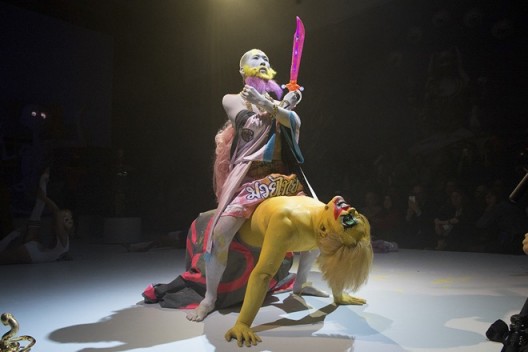
“ADAHA II,” performance, 44 minutes, directed by Chen Tianzhuo, written by Beio and Chen Tianzhuo in association with House of Drama (France) and Grebnellaw (Sweden) starring Beio, House of Drama, Grebnallaw, Han Yu, Dope Girls, Music by Zhiqi, Soviet Pop, Mi Zhang, 2015.
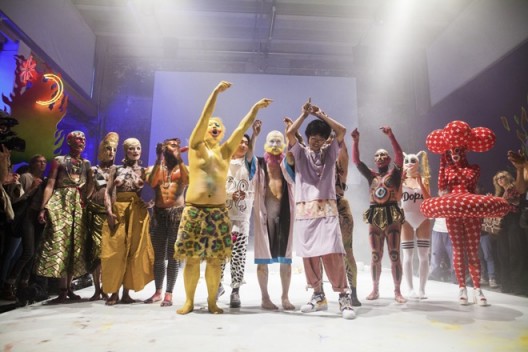
“ADAHA II,” performance, 44 minutes, directed by Chen Tianzhuo, written by Beio and Chen Tianzhuo in association with House of Drama (France) and Grebnellaw (Sweden) starring Beio, House of Drama, Grebnallaw, Han Yu, Dope Girls, Music by Zhiqi, Soviet Pop, Mi Zhang, 2015.
Perhaps to invite the viewers to form their own sense of “order out of chaos,” many of these music videos throughout the exhibition space are not easily comprehensible or accessible. There are no narratives to lead us through the obdurately choreographed dances or the hip-hop rapping. Even the chain-encrusted, metal-mouthed, tattoo-emblazoned “EXTRAODINARY LEGENDARY GANGSTER BLOOD ASIAN TWINS” offer little hint since the rap is sung in Cantonese. Yet, one cannot take one’s eyes off of the large screens replaying loops of “ADAHA II”, “Paradi$e Bitch”, and the rest of the wildly frenetic videos. The visuals are psychedelic and the sights captivating because they are titillating and even voyeuristic. It brings to mind the burlesque shows of Moulin Rouge updated to seduce the contemporary audience.
For Chen, performances are the culmination of a practice which unifies painting, sculpture, installation, video, music, and fashion. “Picnic Paradi$e Bitch” at BANK in Shanghai last year combined the titles of the two videos; “Picnic”, a three channel video, and “Paradi$e Bitch,” a two channel video. The conflated video and the opening night performance were hedonic displays replete with half-naked salivating Asian twin midgets and blonde pony-tailed lady-boy Beio enacting a direct in-your-face performance of orgiastic proportions. Such act of defiant “f*** you” attitude brought Chen Tianzhuo immediately to the media’s attention, as exemplified by the newly launched art journal Kaleidoscope who framed their inaugural issue with glossy visual tributes to Chen Tianzhuo’s work. Many young artists have been pushing the edges of Chinese contemporary art since 1978, but Chen Tianzhuo appeared like a wild savage on the indigenous scene, after having completed his studies in London in 2011, to provoke China’s art scene.
Chen Tianzhuo’s inspiration thrives on what to an older generation may seem hideously grotesque or outright criminal. “I think everyone presumes that my work would run into problems with censorship [in China]. Most of the pieces [in this exhibition] are related to drug culture, but the authorities don’t even know what [my art] is about,” said Chen. Indeed, references to the underground subculture of drugs and LGBTQ pervade throughout Chen’s exhibition at the Palais de Tokyo. The long row of intricately crafted glass bongs in various shapes and guises such as an alien, a Chinese dragon, and human skull gleam and morph under an ever-changing stream of neon light.
The fundamental appeal of drug culture, cult culture, and even institutional religion is that it fulfills the longing for acceptance—the innate desire to be absolved and absorbed into a community. It is this very social construct that took root and was perfected in China which Chen seeks to rephrase. Collective identity in China’s recent past was a joyless chore sustained by sanctioned mandates. In many ways, it is still upheld as an accepted group behavior fraught with “Chinese characteristics”. But what does the twenty-first century paradigm of collective consciousness mean for the current generation of Chinese youths? Perhaps what Chen is striving for is a subaltern voice. He repurposes the drab uniform of conformity and weaves it into a technicolor jacket filled with possibility. Group cohesiveness, under the terms of Chen’s esoteric religion for his partying homies, is no longer bound by fear under the constant scrutiny of human surveillance where one neighbor could betray another. For Chen, an alliance is not something to be dreaded, but a celebration in which the members support one another not only for the quality of sameness, but more importantly, for the differences between disparate members in the body of the group. Herein lies Chen Tianzhuo’s inexorable “utopian longing” that seeks enlightenment, unity, and order through joie de vivre and unapologetic ruckus.
